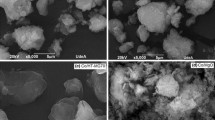Abstract
Processes occurring in the preparation of the Co/ZrO2 + 6% Y2O3 catalyst are studied by temperature-programmed reduction (TPR). The effects of the concentration of Co, the porosity of the support, and the calcination temperature on catalyst reduction were studied. As was shown by continuous magnetization measurements in the course of TPR, metallic cobalt appeared on the microporous support in two temperature ranges irrespective of the precalcination temperature and the concentration of supported cobalt. These factors affect the reduction rate but do not change the maximum temperatures of the corresponding peaks. It is suggested that the first maximum of the Co formation rate is due to the reduction of CoO particles on the surface of the support and within macropores, whereas the second maximum is due to the reduction of CoO particles located within support micropores. Only one temperature range of CoO reduction was found in the macroporous ZrO2 + 6% Y2O3. This effect is likely due to mass transfer in support micropores.
Similar content being viewed by others
REFERENCES
Van der Laan, G.P. and Beenackers, A.A.C.M., Catal. Rev.-Sci. Eng., 1999, vol. 41, nos. 3-4, p. 255.
Iglesia, E., Appl. Catal., 1997, vol. 161, p. 59.
Rohr, F., Lindvag, O.A., Holmen, A., and Blekkan, E.A., Catal. Today, 2000, vol. 58, p. 247.
Feller, A., Claeys, M., and van Steen, E., J. Catal., 1999, vol. 185, p. 120.
Oukaci, R., Singleton, A.H., and Goodwin, J.G., Appl. Catal. A, 1999, vol. 186, p. 129.
Yu, T.-M., Zhou, R.-X., Tang, Z.-M., and Zheng, X.-M., Chem. J. Chinese Univ., 1999, vol. 20, p. 123.
Boot, L.A., van Dillen, A.J., Geus, J.W., and van Buren, F.R., Appl. Catal. A, 1996, vol. 136, p. 69.
Malet, P. and Caballero, A., J. Chem. Soc., Faraday Trans. I, 1988, vol. 84, p. 2369.
Bartholomew, C.H. and Farrauto, R.J., J. Catal., 1976, vol. 45, p. 451.
Chernavskii, P.A. and Lunin, V.V., Kinet. Katal., 1999, vol. 40, no. 3, p. 417.
Rode, E.Ya., Zh. Neorg. Khim., 1956, vol. 1, p. 1430.
Stacy, M.A., Richer, M., Kummer, J.T., et al., J. Catal., 1985, vol. 107, p. 393.
Castner, D.G., Watson, P.R., and Chan, I.Y., J. Phys. Chem., 1990, vol. 94, p. 819.
Ernst, B., Libs, S., Chaumette, P., and Kiennemann, A., Appl. Catal. A, 1999, vol. 146, p. 145.
Author information
Authors and Affiliations
Rights and permissions
About this article
Cite this article
Chernavskii, P.A., Lermontov, A.S., Pankina, G.V. et al. Effect of the ZrO2 Pore Structure on the Reduction of a Supported Cobalt Oxide in Catalysts for Fischer–Tropsch Synthesis. Kinetics and Catalysis 43, 268–274 (2002). https://doi.org/10.1023/A:1015332930882
Issue Date:
DOI: https://doi.org/10.1023/A:1015332930882




